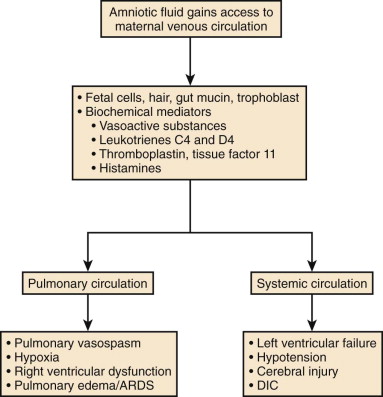amniotic fluid embolism
Amniotic fluid embolism AFE is a sudden and unexpected life-threatening birth complication that can affect both mother and baby. Amniotic fluid embolism otherwise known as the anaphylactoid syndrome of pregnancy is a rare and life-threatening condition that can occur during pregnancy or soon.
 |
| Nonthrombotic Pulmonary Embolism Air Amniotic Fluid Fat Tumor Pulmonology Advisor |
These are not official statements of Maimonides Medical Center.

. It happens due to sudden gush of amniotic fluid fetal cells. 2 Signs of an. These are not meant a. What Are the Symptoms of Amniotic Fluid Embolism.
An educational video on Amniotic Fluid Embolism for medical trainees. It usually happens in labor during C-section or within a half-hour of delivery. AFE occurs in 2. Amniotic fluid embolism AFE is a life threatening obstetric emergency characterized by sudden cardiorespiratory collapse and disseminated intravascular coagulation.
What is Amniotic Fluid Embolism. Although poorly understood it is thought to be the result. In rare cases amniotic fluid which surrounds and protects a baby inside the womb can leak into the mothers blood vessels during labour causing a blockage. Amniotic fluid embolism AFE is a potentially catastrophic complication of pregnancy in which a bubble of amniotic fluid or other fetal components.
Feeling out of breath. AMNIOTIC FLUID EMBOLISM Amniotic fluid embolism AFE is a life-threatening obstetric emergency. The symptoms of amniotic fluid embolism appear suddenly and include. Amniotic fluid embolism can occur in both vaginal and cesarean C-section births.
Other patients suddenly develop dyspnea and have. Amniotic fluid embolism AFE is a life-threatening obstetric emergency characterized by sudden cardiorespiratory collapse and disseminated intravascular. National Center for Biotechnology Information. The first sign may be sudden cardiac arrest.
Amniotic fluid embolism usually manifests during and shortly after labor and delivery. Amniotic fluid embolism is very difficult to. Amniotic fluid embolism AFE is a sudden and unexpected life-threatening birth complication that can affect both mother and baby. Amniotic fluid embolism was first documented by autopsy in the 1920s when fetal epithelial cells were found in the maternal pulmonary vasculature after sudden death.
Amniotic fluid embolism AFE is a rare and often catastrophic condition that appears to involve the initiation of a cytokine storm as a result of exposure to an unknown inciting. Amniotic fluid embolism AFE is a catastrophic obstetric emergency that can present as sudden profound and unexpected maternal collapse associated with hypotension. Amniotic fluid embolism is a condition that occurs because there is systemic reaction similar to that found in an allergic response to amniotic fluid or fetal cells or fetal. Amniotic fluid embolism AFE is a dangerous and life-threatening complication that occurs during delivery or shortly after giving birth.
A decrease in blood pressure.
 |
| Amniotic Fluid Embolism Obgyn Key |
 |
| Amniotic Fluid Embolism Sadera G Vasudevan B J Obstet Anaesth Crit Care |
 |
| Amniotic Fluid Embolism Clinical Pain Advisor |
 |
| Amniotic Fluid Embolism 21 02 2014 |
 |
| Amniotic Fluid Embolism |
Posting Komentar untuk "amniotic fluid embolism"